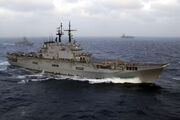| Greco-Italian War | |||
|---|---|---|---|
| Date: | October 10, 2009, 10:30pm GMT - | ||
| Location: | Mediterranean Sea | ||
|
Casus belli: |
Italian attack on a Greco-Libyan Oil Tanker | ||
| Result: |
Conflict Ongoing | ||
|
| |||
The Second Sicily War (Greek: Δεύτερος πόλεμος της Σικελίας, Italian: Secondo luogo guerra della Sicilia) also in its early stages as the Greco-Sicillian War is An Ongoing armed conflict between Greece, and the Italian Remainder Provinces.
Origins of the War[]
The First Italy War broke out in late October 2008 and gradually escalated until late December, when the Italian Remainder Provinces requested a ceasefire. Peace talks were never held.
The Platea Incident[]
Italy, seeing an opportunity, re-ignited the conflict early in October, 2009. Men from a Italian ship attempted to board a Greco-Libyan oil-freighter, the SS Platea on October 10, 2009 at 7:33pm GMT. The Greeks, Egyptians, and Libyans on the freighter (with 2 casualties) were able to fend off the attack, killing 3 and capturing 2. The other four men were able to flee back to their own vessel. Originally the crew believed them to be pirates, until the flag of Italy was seen hanging from their stern. The oil-tanker was able to sail to the Greek-mandate of Cyrenaica, and the government in Skyros was radioed, alerted to the violence.
Declaration of War[]
At midnight on Saturday October 10th local time, an emergency meeting was convened of the different delegates of the new Confederation of Greece. At 12:30 the Confederation of Greece declared war on Sicily, having gave it 24 hours to apologize and meet the earlier demands given to it, to which they did not respond. The Atlantic Defense Community at its member states were alerted.
Mobilization soon followed.
The Conflict[]
The Opening Moves[]

The Greek Frigate HS Psara sailing of the coast of Ithica, October 14th 2009
The Hellenic Navy was the first to go into action, when on October 11th, at 16:12, the Greek Missile Ship HS Krystallidis engaged and sank the Sicilian Submarine Salvatore Pelosi.
Sicilian Movements[]
On October 13th, Greek troops began amassing on Kerkyra, giving the impression an invasion of Apulia would take place. However, Greek troops stationed in North Africa have already encountered naval-fighting miles from the Libyan coast at Cape Matapan. Another disturbing event has been revealed to the world; Greek intelligence learned from Dawada tribesmen the Sicilians were gathering their North African military in various eastern-Tunisian villages, no doubt preparing for an invasion of both the land and sea.
First Blood: The Second Battle of Cape Matapan[]

the Elli Class Frigate Kortenaer at battles stations, during the Second Battle of Cape Matapan
The Main Sicilian Fleet Set sail out of Messina on the 16th October, planning to eradicate the Greek Fleet and clear the Mediterranean. Greek Spies reported the fleet's movement out of Messina, and the Greek Submarine HS Poseidon shadowed the fleet, radioing its movements to New Athens. the Hellenic navy hastily scrambled to intercept the Sicilian warships. The Greek fleet moved to intercept the Sicilian ships of Cape Matapan, where on March 29, 1941 a Italian fleet was sunk by the Allied powers.

Part of the Sicilian Warfleet (Including the Carrier Giuseppe Garibaldi) off Cape Matapan on the Morning of October 21st, 2009
Action Stations was sounded at 10:00 Hours GMT, and Admiral Ioannis Karaiskos sent the Message out to the fleet 'We fight for Survival. There is no turning back. Either we win, or we sink'
Contact was made with the Sicilian fleet at 10:27, and the first shot was fired from the Sicilian ship Orizzonte at 10:43. a general exchange of missiles soon followed, with the Greek Ships coming worse off. However, as the Sicilian ships cruised closer, a lookout spotted a volley of missiles coming from the Starboard side. Part of the Greek fleet had been detached to flank the Sicilians. they turned to get out of the way, only to make them even easier targets to the ships at the front. the Sicilian warship Sibilla suffered three hits and started to sink, soon followed by the Destroyer Ardimentoso. as he Sicilian fleet maneuvered o deal with these twin threats, it came under attack from the port side, by the Greek Submarines HS Papanikolis, HS Okeanos, HS Glafkos and HS Katsonis. Caught on three sides, the Sicilian fleet began to disintegrate. The flagship, the carrier Giuseppe Garibaldi, suffered four direct hits and began to list heavily.
Invasion of Libya[]
On October 22nd, the Sicilian Africa Army began its full scale invasion of Greek Libya. the move was timed to coincide with the Sicilian fleet's attack, which ended in disaster. the land attack went ahead anyway, and initially steamrollered over the Greek defenders. by the 24th, Benghazi fell.
